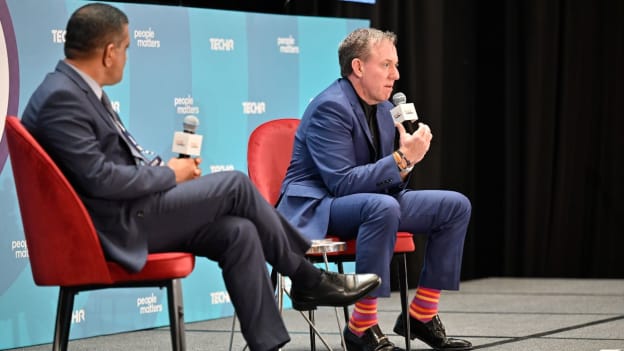Unveiling practical applications of AI in HR at 2023 TechHR Singapore

“Is everyone using AI? The answer is yes!” asserted Jason Averbook, Senior Partner and Global Leader of Digital HR Strategy at Mercer, demystifying AI technology in an exclusive fireside chat with Arun Dhaka, VP - APAC & Japan of Darwinbox at TechHR Singapore 2023 by People Matters.
The session titled ‘From Hype To Reality: Unveiling Practical Applications Of AI In HR’ began with Arun stating, “Amidst this rapid pace, a question arises: am I moving swiftly, or is the world accelerating even faster? The impetus for this introspection arises from remarkable developments – Goldman Sachs predicting AI's impact to surpass even that of electricity, a profound proclamation. Concurrently, the recent unveiling of a language model by Meta, adeptly translating speech and text across 100 languages, stands as a compelling case for HR integration. With this innovation, we envision more accessible town halls and feedback sessions, seamlessly transcending language barriers. This technological leap brings forth a more streamlined and enriched workplace experience.
Delving deeper into this evolving landscape, Bloomberg's projection of a $1.3 trillion AI economy demands attention. Within this burgeoning sphere, product providers and vendors poised to engage with generative AI hold a promising market segment, potentially capturing between $280 to $500 billion. As we dissect this topic, let's commence with a fundamental question: What does AI truly encompass?”
Jason responded, “How will artificial intelligence impact HR organisations worldwide? To embark on this journey, we must first grasp what AI entails beyond its mere two-letter abbreviation.” He further questioned the audience about employing AI for their operations and said, “AI is indeed a part of our operations, whether we agree or not. To understand this, let’s swiftly traverse the landscape of the four generations of AI.”
The four generations identified in the landscape of AI are:
First Gen - Rules-based AI
Explaining with the example of Spell-check, Jason elaborated, “For those among you who utilise spell-check, you're already engaging with AI. Now, let's explore the first generation of AI – a realm rooted in rule-based systems. Essentially, it operates on the principle of "if X, then Y." Now, I'm aware that some may argue this isn't true AI, but in essence, it constitutes the first phase. To illustrate, consider the following scenario: "If I graduate from this school, you might consider hiring me. If I don't graduate from this school, you might not consider hiring me." However, let's not sugarcoat it; this incarnation of AI was rather rudimentary, and in many ways, it still is. An example to highlight its limitations: if I misspell the school's name, the system fails to recognise me. This version operates within strict rules and parameters, characterised as Generation One or rules-based AI.”
Second Gen - Machine Learning
Identifying key traits of the second-gen in the AI landscape, Jason said, “Machine learning marks the juncture where intelligence begins to grow, both for the machine and myself. It's as if the machine raises its hand and declares, "Hey, folks, listen up. If I graduate from that school and it falls within one of five categories, let's take it into consideration." Or it might say, "You know what, even if I omit the period after 'St.' when mentioning St Thomas, that's alright." The machine embarks on a journey of learning and enhancement, gradually refining its acumen. Another form of machine learning is - Imagine you've watched something, whether on TV or OTT platforms and suddenly, there's a barrage of recommendations following suit. This rudimentary form showcases the essence of machine learning. While it may not delve into the depths of deep learning, where, for instance, it deduces that you, an individual of 54 years, might prefer content enjoyed by others in the same age bracket, it operates on simpler principles. It evaluates your actions and preferences to say, ‘Given what you've shown interest in, you might also find this intriguing.’ This is similar to YouTube recommending content based on your clicks.”
Third Gen - Deep Learning
Elaborating on deep learning, Jason explained, “It takes us beyond the realm of the straightforward YouTube analogy. While the basic form of machine learning entails observing my clicks and predicting what might intrigue me, deep learning amplifies this process. It's not just about where I clicked; rather, it's about identifying patterns in the clicks of individuals who share my preferences. Imagine me as an instance - let's call it ‘Jason’. Deep learning scrutinizes not only my actions but those of individuals similar to Jason. Suppose, as a machine, I ascertain that around 500K people have viewed both ‘How a Shark Eats a Small Fish’ and ‘How to Sew a Basket.’ It might sound peculiar, yet these patterns prompt the machine to discern correlations. The outcome? The machine comprehends that there's a potential alignment between the interests of those who delve into these two seemingly disparate subjects. Consequently, it might suggest content to me based on this underlying pattern. Gone are the days of rigid, hand-coded rules. No more ‘if you watch a shark-related video, it must be followed by this particular type of content.’ The machine now possesses the sagacity to discern these relationships independently. This realm of innovation exemplifies the power of machine learning, transitioning from rudimentary recommendations to complex pattern recognition, epitomised by deep learning.”
Fourth Gen - Generative AI
In the current landscape, generative AI takes centre stage by producing content. This marks the inaugural form of AI that actively generates content. Unlike its predecessors, which often operate subtly in the background, influencing consumer experiences or, in our context, enhancing employee experiences, generative AI steps into the forefront as a content creator.
Reshaping the dynamics of the AI Landscape
As we embark on our experimentation journey, we unlock the vast capabilities inherent in these AI tools. Jason explains, “The initial revelation of these AI capabilities often leaves us in a state of awe. Consider, for a moment, your inaugural encounter with chat GPT. Reflect on your thoughts when you posed your first query. The outcome, it seems, hinges upon the nature of the question itself. The exchange that follows, however, is intriguing. It's almost surreal – a computer typing back responses. This experience, in itself, is profoundly enlightening. Yet, the allure of generative AI goes deeper, prompting us to delve into a critical distinction – that between generative AI and search engines. In today's realm, traditional search operates on a one-shot basis. Visualise the last time you turned to Google, seeking an answer. Perhaps it was ‘USD to SGD’. However, if your inquiry lacked precision – omitting specific conversion values – the outcome may have been a collection of documents, calculations, or outdated content from five years ago. This outcome likely left you unsatisfied.
Here lies the innovation of generative AI, as it perpetuates the conversation. Imagine entering ‘USD to SGD’ into a generative AI tool. The next response isn't an endpoint; it's a continuation. ‘I know how to do this. Why don't you tell me what you're trying to convert? How many USD to SGD? Or are you aiming to convert SGD to USD?’ The magic lies in its adaptive content generation, an intricate dance based on your previous input. Should you respond with ‘100’, the generative AI doesn't stop. It inquires further, asking whether you meant 100 USD or 100 SGD. Do you perceive the distinction? Compare this to a traditional search experience – a list of hopeful answers, but a solitary attempt. Generative AI, on the other hand, engages in a reasoned dialogue, evolving responses until your quest is fulfilled. And when you've achieved your desired outcome, there's a polite gesture awaiting – a simple ‘thank you’. It might sound trivial, yet it's significant. Thanking generative AI isn't mere jest; it's a meaningful act. Why? Because it learns from you. Just as it tailors your YouTube recommendations, it adapts to your preferences across domains. It learns to accommodate your emotions, marking a unique stride in HR technology. Unlike conventional vendors, generative AI is crafted to elevate your spirits, enrich your cognitive horizons, and inspire progressive thinking. The profound impact of this paradigm shift is undeniable. Generative AI is ushering in an era of technology with a singular goal – your happiness and intellectual growth. It's a transformative force, poised to revolutionise HR and beyond.”
Revamping HR Jobs with Generative AI
A global transformation is underway in the role of HR due to generative AI, and the two crucial aspects, as explained by Jason, are, “Generative AI is poised to reshape every facet of HR roles. It's a transformative force that will touch each dimension of HR jobs. Whether it's designing training programs, crafting training content, formulating job descriptions, conducting HR analytics, generating reports, shaping policies, or any other task – even manual data entry, your days of carrying out those specific tasks are numbered. Generative AI is on track to revolutionise all of this.
We typically categorise work into three realms: hands-on work, heads-on work, and hearts-on work. Within the next year or two, generative AI will effectively eliminate the need for hands-on work. Consider your HR business partners, often entangled in transactional tasks. Generative AI will liberate them from this routine and direct their focus toward cognitive and empathetic work - the heads and hearts domains.
Moreover, the transformative wave isn't contained solely within the realm of HR. It will cascade into other fields as well – lawyers, accountants, coders, and call center agents, to name a few. This seismic shift has profound implications for HR. This impending transformation demands our thorough understanding and preparedness.
It's imperative to note that not all applications of generative AI will pertain to HR. Therefore, waiting for HR-specific applications to emerge is a misguided approach. Instead, we must acknowledge that other aspects of our professional landscape will inevitably shift due to generative AI. However, within HR applications, vendors like DarwinBox are at the forefront, making processes smoother, more efficient, and more effective by embedding generative AI. The integration occurs not just in the mechanics but in the journeys that your managers and employees traverse every day. Organisations will soon house Large Language Models or multiple such models – the very essence of generative AI's capabilities.”
Organisations need AI Governance Policy
AI governance is imperative for every organisation, and the onus falls on the HR function to establish it, suggested Jason. Explaining further, he said, “Consider this – could you extract a spreadsheet of employee salaries, names, years of service, addresses, and share it randomly via email? The answer is yes, you could, but no, you wouldn't. Now, in the realm of generative AI, could you employ it to draft policies and procedures that don't align with your company's ethos? Yes, but you can't simply deflect responsibility to generative AI. It's about trust and accountability. Think of it as HITL – humans in the loop. The output should amplify human capabilities, not replace them. Governance steps in to define how to utilise AI. Whom do you send it to? How do you cross-check it? Is there potential bias? Speaking of bias, let's dissect an instance involving GPT. In the United States, for instance, there's a disparity between left-wing and right-wing demographics, with the left-wing being more educated overall. Now, if GPT appears biased towards the left-wing, it's because more left-wing individuals are using it – largely for educational and professional purposes. However, you're not restricted to the public domain. You'll have your own private instance of a large language model. This signifies a crucial distinction. Your private model will operate on your data, and your insights, shaping biases according to your context. And the beauty is, if biases arise, you'll have the capacity to fine-tune your private large language models. This autonomy empowers you to tailor messaging, cultivate trust, and ensure alignment. AI governance isn't merely about compliance; it's about cultivating a responsible AI ecosystem that enhances human collaboration and enriches outcomes.”















